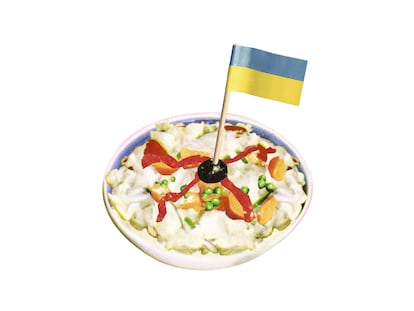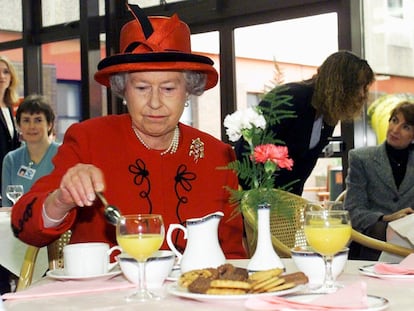The Basque cheesecake taking Turkey by storm
Tourists in Istanbul are lining up at pastry shops and cafés to get a taste of the renowned dessert invented at La Viña restaurant in San Sebastián, Spain.
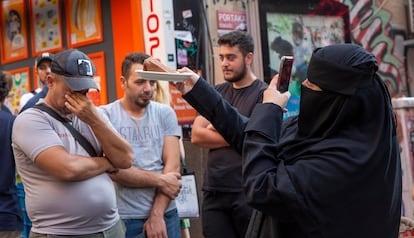
The San Sebastián Cheesecake has become the main attraction at Istanbul’s most popular pastry shops and cafés. Customers line up to buy a slice, watch it jiggle on the plate, and then snap some photos and selfies to immortalize the moment on social media before taking their first bite. The cheesecake, also known as the Donostia Cheesecake for its origins in the Basque Country (Donostia is the Basque name for San Sebastián, the capital city of Spain’s northern coastal province of Gipuzkoa), is now a major hit in Turkey. The pastry is a replica of the famous cheesecake that San Sebastián’s La Viña de la Parte Vieja restaurant has been serving for over three decades. The creator of this unique dessert, Santiago Rivera, says he was surprised by the international reception of his prized gastronomic creation: “We are very grateful. We have never done anything to promote the cake’s success. It became famous on its own, because people liked it,” he says.
Lining Istanbul’s busiest and most popular tourist streets — the ones that lead to the Galata Tower — are signs advertising the cheesecake. The establishments that serve it tend to have only a vague idea of the pastry’s origins, and would be hard pressed to locate San Sebastián on a map. Nor do they know when or how the craze for the cheesecake came about, or that it’s a copy of an original recipe from Spain. Apparently, pastry chefs in the Turkish capital say, the cheesecake’s sudden popularity is the result of a trend fueled by social media influencers, which has since gone viral. There are scores of photos on Instagram featuring the San Sebastian Cheesecake with the Galata Tower in the background. Rivera says that the dessert’s notoriety may have first been sparked by the praise that the The New York Times bestowed upon La Viña’s recipe in 2021. Rivera, the author of that recipe, describes the cake as follows: “It’s a small wonder that has brought me a great deal of joy.”
“La Viña’s cheesecake created a new style, and new variants of that style have been popping up around the world ever since,” Rivera says. “In Turkey, it’s become something of a social phenomenon. It’s also very well-known in Japan and has fared well in the United States, too. I’ve been told it has reached as far as Australia, and that the French are also starting to get excited about it.” Rivera, 62, says that it took him three years to perfect the recipe. He began to experiment with the idea in 1987, and finally added it to the restaurant’s menu in 1990. “Over time, our clientele made it famous,” he says. At first, he was baking two cakes a day, then six, then 10... Now, Rivera says the restaurant bakes an “unspeakable” number of cakes every day. At 7am, the restaurant is already preparing a batch of 20 for the day.
On Thursday morning before the restaurant has opened, a line of Japanese tourists, cellphones in hand, forms outside the doors of La Viña. A guide leads another group of tourists along 31 de Agosto Street, announcing as she passes by La Viña, “Here, on the left, the famous cheesecake...”
La Viña’s renowned cheesecake is about four inches thick and is sweet, creamy, and jiggly. The dessert’s preparation is no mystery: it’s a simple recipe, and Rivera has never tried to keep it a secret. It requires only five ingredients: one kilo of cream cheese, half a liter of cream, a tablespoon of flour, seven eggs and 400 grams of sugar. The restaurant has about 50 cakes on its display shelves, ready to satisfy the relentless daily barrage of to-go orders, for €5 a slice, or €45 for a whole cake.
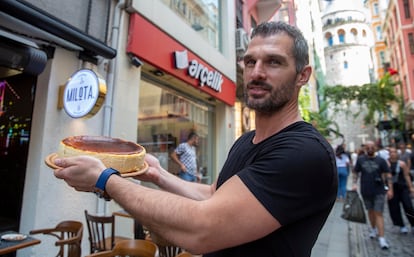
In Istanbul, there are now special tour guides that publish the addresses of establishments that sell the San Sebastián Cheescake. One of these guides describes the dessert as a “special” cake that “melts on the tongue with its unique texture.” Its preparation, according to the publication, “requires a certain mastery to maintain the cake’s consistency and ambitious flavor.” While the craze for the Donostia Cheesecake spread to Turkey — where it sells for about 20 Turkish liras, or just over one euro — largely as a result of social media, the original La Viña version rose to fame in a more artisanal way: through word of mouth. That, in tandem with the praise the recipe has received from famous chefs such as Hilario Arbelaitz and Dabiz Muñoz, who both created their own interpretations of the cake, as well as reviews in various media outlets, have given the cake its international reputation. The New York Times named it a “flavor of the year” in 2021, it has been featured on Japanese television, and EL PAÍS’s own food guru El Comidista awarded it “number one” in a selection of four outstanding cheesecakes.
Rivera says he has never tasted any of the international versions of his recipe, but he is convinced that “none of them taste the same” as his, because, while “they may all be about 85% the same, 15% depends on the small details”: the type of oven, the batter, the temperature of the room as it rests, etc. “There’s no one trick,” Rivera says, adding that at La Viña, “we only serve it plain, without any accompaniments, so that it doesn’t lose its cheesy flavor.” In Turkey, on the other hand, customers usually eat it smothered in a bath of melted chocolate, or with dried fruit jams.
La Viña, which was first opened by Rivera’s parents and relatives in 1959, when restaurants in the Parte Vieja — the city’s Old Town district — would only serve wine and anchovies that came directly from the port city’s docks, has now had to open an additional bakery at a nearby location, which is slated to open in late 2023. Until then, the restaurant will continue to bake its cheesecakes on-site in its tiny kitchen, using just one single oven with the capacity to cook only five cakes at a time. Regardless of its reputation abroad, La Viña’s cheesecake will have a long life, says Rivera, encouraged by something his father told him many years ago: “If you’ve done something well, never stop doing it.”
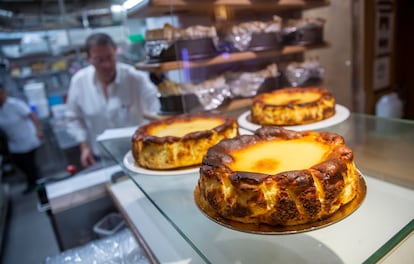
Tu suscripción se está usando en otro dispositivo
¿Quieres añadir otro usuario a tu suscripción?
Si continúas leyendo en este dispositivo, no se podrá leer en el otro.
FlechaTu suscripción se está usando en otro dispositivo y solo puedes acceder a EL PAÍS desde un dispositivo a la vez.
Si quieres compartir tu cuenta, cambia tu suscripción a la modalidad Premium, así podrás añadir otro usuario. Cada uno accederá con su propia cuenta de email, lo que os permitirá personalizar vuestra experiencia en EL PAÍS.
¿Tienes una suscripción de empresa? Accede aquí para contratar más cuentas.
En el caso de no saber quién está usando tu cuenta, te recomendamos cambiar tu contraseña aquí.
Si decides continuar compartiendo tu cuenta, este mensaje se mostrará en tu dispositivo y en el de la otra persona que está usando tu cuenta de forma indefinida, afectando a tu experiencia de lectura. Puedes consultar aquí los términos y condiciones de la suscripción digital.
More information
Últimas noticias
There is as much life left to discover on planet Earth as that which is already known
Dozens presumed dead, around 100 injured in fire at Swiss Alps bar during New Year’s celebration
Is porn for women different from conventional porn? We spoke to those who make it
Cartagena de Indias is sinking: What can the city do to mitigate it?
Most viewed
- David King, chemist: ‘There are scientists studying how to cool the planet; nobody should stop these experiments from happening’
- Reinhard Genzel, Nobel laureate in physics: ‘One-minute videos will never give you the truth’
- Oona Chaplin: ‘I told James Cameron that I was living in a treehouse and starting a permaculture project with a friend’
- Sinaloa Cartel war is taking its toll on Los Chapitos
- The Interoceanic Train, the Mexican alternative to the Panama Canal

